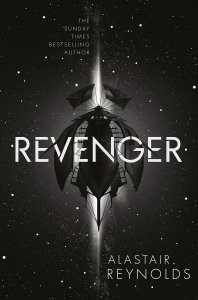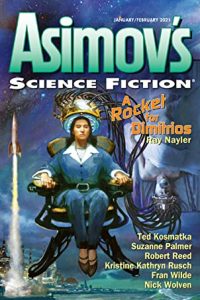Russell Letson reviews Alastair Reynolds
Revenger, Alastair Reynolds (Orion/Gollancz 978-0575090538, £18.99, 432pp, hardcover) September 2016; (Orbit 978-0-3165-5556-2, $14.99, 560pp, tp)
February 2017.
 In Revenger Alastair Reynolds inserts a distinctly old-fashioned space opera into a Stapledonian milieu right out of Last and First Men, a solar system rendered unrecognizable by millions of years of natural and unnatural processes. Reynolds has used the ancient-far-future trope before in, for example, House of Suns (reviewed in August 2009), but in that case the protagonists are post-human and the story line takes place across as well as after millions of years, and involves multiple 200,000-year circumnavigations of the galaxy. Revenger is set in a single period and within the limits of the solar system, but on the very, very far side of many historical discontinuities. There is, to be sure, plenty of familiar, conventional-SF futurity furniture here – a settled solar system, swarms of space habitats, exotic technologies, aliens, and so on – but it is felt to be located in a multilayered, imperfectly-known and -understood, fragile area of light that sits atop an abyss of lost time and vanished empires.
In Revenger Alastair Reynolds inserts a distinctly old-fashioned space opera into a Stapledonian milieu right out of Last and First Men, a solar system rendered unrecognizable by millions of years of natural and unnatural processes. Reynolds has used the ancient-far-future trope before in, for example, House of Suns (reviewed in August 2009), but in that case the protagonists are post-human and the story line takes place across as well as after millions of years, and involves multiple 200,000-year circumnavigations of the galaxy. Revenger is set in a single period and within the limits of the solar system, but on the very, very far side of many historical discontinuities. There is, to be sure, plenty of familiar, conventional-SF futurity furniture here – a settled solar system, swarms of space habitats, exotic technologies, aliens, and so on – but it is felt to be located in a multilayered, imperfectly-known and -understood, fragile area of light that sits atop an abyss of lost time and vanished empires.
The novel doles out this background in hints and details rather than big expository lumps: over more than ten million years, civilizations have risen and fallen in eras called ‘‘Occupations’’ (this is the year 1799 of the current one). Multiple alien species have visited the solar system (and some have stayed around), while it has been completely rearranged. There is no mention of planets circling the Old Sun, only the Congregation, a swarm of twenty thousand habitats of all shapes, sizes, ages and states of repair; and millions of other objects called ‘‘baubles,’’ the mysterious, locked-up, and sometimes dangerous remnants of earlier Occupations. (This book does not seem to be part of the Revelation Space sequence, but this de- and reconstructed solar system has echoes of the far end of that series.)
It is a world that offers romantic adventure to the well-brought-up but restless daughters of a shabby-genteel widower. The narrator, Arafura Ness, is persuaded by her older (and officially adult) sister Adrana to escape their father’s smother-love (and the creepy ministrations of the family doctor) by signing on with Captain Rackamore of the sunjammer Monetta’s Mourn as bone-readers (we will return to that job description). Rackamore and his crew are scavengers, seeking out and rummaging through baubles, hoping to find scraps of near-magical technologies left over from earlier Occupations. Typical miscellaneous swag includes
Thirty sheets of Prismatic Ironglass – tougher than any we’ve seen. A pretty jade box with a pair of duelling pistols, Empire of the Atom. A space helmet, done up with horns. A sword that teaches you how to swing it. Half a robot. A skull or two….
In addition to the kind of engineering and maintenance specialists one would expect on a spaceship, a scavenger crew requires specialists who can figure when the impenetrable fields surrounding a bauble will open and close; who can get past the locks and traps that guard the interiors; who can sniff out the most valuable and useful items. And every ship needs someone who can detect and interpret the signals from the bones – huge skulls (like the ones in the above-listed inventory) laced with enigmatic and somehow interconnected tech, left behind by an alien species that likely passed through the neighborhood long before any of the Occupations. ‘‘Bone reading’’ – a strange kind of instantaneous communication – requires not only inborn talent but neuroplasticity, and Adrana and Arafura have both the gift and the youth, which makes up for their naiveté and lack of practical spacefaring experience, so Rackamore takes them on.
What follows combines a YA coming-of-age story with a pirate adventure: Monetta’s Mourn is attacked and robbed by the legendarily cruel and effective Bosa Sennen of the legendarily scary Nightjammer. The sisters are separated when Adrana is dragooned into being the pirate’s new bone reader, and Arafura must first survive and then figure how to track down Nightjammer and rescue Adrana. In the course of doing so, she must also reinvent herself, changing from a well-mannered, book-educated girl into a tough, experienced, and even ruthless spacer who is not above lying and manipulating others – even her friends and allies – to achieve her ends. The rest of the tale involves disguises, psychological and physical transformations, chases & escapes, kidnapping, brainwashing, betrayals, sacrifices, cut-throatery, explorations of spooky treasure troves, deployments of exotic weaponry, and various trapdoors and revelations.
While this is a pirate-adventure/space-opera/ treasure-hunt tale, that is only one side of its appeal. In fact, the setting may be more than half the fun: a space-dwelling, spacefaring civilization that only partly understands the technologies that sustain it; that lives in the multiple shadows (and the abandoned homes) of more accomplished and powerful forbears; that has an economy partly driven by scavenging in the ruins of those vanished Occupations; that doesn’t know why aliens like the Crawlies are so interested in running its financial system. It’s a world of riddles and puzzles and blank pages, which means it’s also a world full of strange turns and surprises, as well as treasure hoards and reavers and exotic ports of call.
Accordingly, Arafura does get where she said she wanted to go, though that destination is not quite what she had imagined at the beginning – which is one of the things one looks for in a story. And the end of her quest looks suspiciously like a pause before the beginning of a pursuit of answers to a new set of riddles, and (one hopes) more glimpses of how this ancient future came to be.







